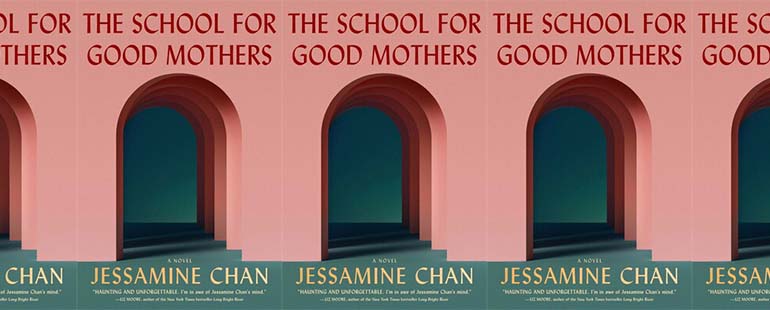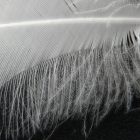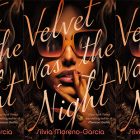“Writing about motherhood provides a great vantage point from which to write about society”: An Interview with Jessamine Chan

The School for Good Mothers, Jessamine Chan’s debut novel, opens on what Frida will continually recall as “her one very bad day.” Frida is an exhausted, newly single mother and the police are calling—she has left her daughter unsupervised and now they have her. This moment catapults both Frida and the reader into a world in which motherhood is closely monitored and, when mothers are found lacking, becomes a subject to be studied at a school billed as a rehabilitation program. The program will take one year. Like Frida, I have a baby at home. The opening pages of The School for Good Mothers represented the first but far from the last moment the novel made me anxious enough that I considered sneaking into my daughter’s bedroom to soothe myself with a peek at her sleeping face.
Chan, too, can trace Frida’s journey to a single day, which she told me about when we spoke late last year. But unlike Frida’s, her day was a good one. A couple years after completing her MFA, Chan decided to build her own writing retreat using two weeks of vacation days and a friend’s house in upstate New York. After a few snowstorms and one terrible idea after another, she sat down to what most writers hope for but so rarely get: six hours in a trance and the foundation of what would become her debut, out today. She originally imagined it as a complicated and dense short story, and in some ways the novel retains the density you can imagine it having in a short form. Once Frida arrives at the school, the setting is claustrophobic. The mothers are monitored and tested and speak to their own children only once a week, a privilege that can be revoked when they fail to meet the exacting standards held by the women in pink lab coats who keep the school going.
At the school, Frida meets women who, at times, become a collective voice in the novel. The School for Good Mothers is written with a close third-person narrator and occasionally the viewpoint zooms out to show the communal experience. This gives Chan the chance to build the reality of the school, and it also reminds me of the way women seem to stumble into groups of moms once they’ve crossed into parenthood. Motherhood and the school are the only ties that bind these women together, and their varied reactions to their circumstances illuminate the absurdity of the setting.
Surveillance and performance are at the heart of The School for Good Mothers. Frida’s daughter is with her ex-husband and his new wife and when Frida imagines her daughter’s life it is sometimes through the prism of the new wife’s Instagram account. The mothers at the school are always performing, both for each other and for their judges. Chan described the novel to me as a place to hold all her own worries about having a child; for anyone who has been through the early days of parenthood, the worries are familiar. Am I a good mother? we think. And also, Do I look like a good mother? The mothers in the school list their charges by way of introduction (“Neglect.” “Neglect and abandonment.” “Neglect and verbal abuse.”); doing so is not so much a means of explaining their experiences or hardships as it is a performance of these experiences for an outsider. They offer their stories up for observation not unlike the way a reader observes characters narrating their own stories. Could this, I wondered at each page, chapter, and month that passed for Frida, be the whole story?
Would I be able to pass these tests?
The largest question for Frida, of course, is whether she will be reunited with her daughter when this surreal year is over. For the reader, it is whether Frida changes or only appears to change—something that is never quite settled. These double-sided expectations are the heart of the novel. Motherhood is deeply personal and yet easily judged by Instagram followers and the state alike. Can motherhood be measured by the performance of it? Frida is judged for her words, or how quickly she learns “motherese,” and yet I found her motherhood most compelling in her silences, when she ran the math of her daughter’s disappearing toddlerhood and built an imagined future.
Margaret LaFleur: Your novel is often described as dystopian, and is frequently compared, perhaps inevitably, to The Handmaid’s Tale. I’m curious about if you see the novel as belonging to any particular literary traditions, and if you see it as in conversation with any particular novels.
Jessamine Chan: Being compared to The Handmaid’s Tale in any capacity is thrilling beyond my wildest dreams. If my book is dystopian, I think it’s dystopian in a minimalist way. It’s much more realistic than many novels in this genre, since my goal was to do only the most essential world-building and leave the rest to the readers’ imaginations. I think of Frida’s story as a quest. At its heart, it’s about a mother fighting to get her child back. I don’t tend to think about literary traditions while writing, but now that the book is in the world, I would absolutely love for The School for Good Mothers to be read alongside Nightbitch by Rachel Yoder, Never Let Me Go by Kazuo Ishiguro, Red Clocks by Leni Zumas, 1984 by George Orwell, and Orange World by Karen Russell. It’s also in direct conversation with the short story “Moving On” by Diane Cook, which was included in her brilliant collection Man V. Nature, and partly inspired the school.
ML: This is likely my bias as a mother of young kids and something with an interest in fiction that deals with motherhood, but it seems like motherhood has become a more common literary theme in recent years. What drew you to motherhood as a driving literary force?
JC: For me, the pull toward this subject matter came from my intense anxiety about whether or not to have a baby. And then once I had my daughter, the book was a place where I could store all my questions and thornier feelings, and where I could think about things in our culture that troubled me. I was studying motherhood in real time: my biggest fears, things I found ridiculous, how mothers talk about their children, how they talk to each other. When I first showed an early draft to Percival Everett at Bread Loaf 2014, he said that if I could get this story right and really build this world, I’d have my finger on the pulse of culture. That’s very exciting to hear, but very hard to do! I don’t think I understood this until the book was finished, but writing about motherhood provides a great vantage point from which to write about society.
ML: Frida, the main character, is sent to this new reform school by the state. I appreciated the dry humor of the novel, which often comes across in showing the state’s out-sized reactions to Frida’s small mistakes or flaws. It gives the novel a level of absurdity. How do you see humor at work in The School for Good Mothers? Is there any relief for the characters in this absurdity? Do you think there is relief for readers?
JC: I’m so happy you enjoyed the humor! I was certainly writing to entertain myself as the years went on, so I could only hope other people would find my jokes funny too. Many aspects of parenting in America, including the expectations we have of mothers and how we judge them, are absurd, besides being unjust. My book takes elements from real life (such as the direction to pay close attention to your child) and pushes them to a crazy extreme. It’s always been difficult to describe the book’s humor, so I tend to cite the film The Lobster, which is exactly the wicked deadpan humor I’m going for. I do think humor provides opportunities for characters to bond and provides some relief for readers, because Frida’s journey is quite stressful. I’ve been trying to spread the word that there are some funny ha-ha moments in the book too.
ML: The novel takes place over a year, but we don’t know what year it is. It is the future, but a future that is entirely recognizable as today. There are hints about some differences from our time—references to climate change, and an important jump technology that plays an important role at the school. How did setting the novel in a near future allow you to explore the themes of surveillance and control of motherhood that a present-day setting would not?
JC: The near-future setting and made-up technology were there from the very first draft, before I even knew that I was starting a novel, and then the challenge became finishing the book before any of the technology became real. I don’t think a totally realistic present-day setting would have allowed me enough room to play. Somewhere in my subconscious I was pondering what-ifs. What if you could actually measure a mother’s love? What if you could measure how much she pays attention to her child? What if there was a one-size-fits-all standard by which to judge parenting?
I made a conscious decision not to state the year or refer to current politics because I didn’t want to date the story. There are just a few references to other technology or laws that have changed. (I should mention that I’m a total luddite.) The technology in the book makes literal the feeling that a lot of parents have of being watched and judged. A kind reader (who has a baby) told me that the women in pink lab coats captured the feeling she has of being watched on the playground every day, which was the greatest compliment.
ML: The future setting acts as a mirror for our present day. If technology is slightly more advanced in the novel, society’s prejudices are firmly entrenched or sliding backward. In particular, I wondered how you see the relationship between the two: technology and oppression. How can technology mirror our oldest (and worst) inequities and biases?
JC: This is a great and terrifically challenging question. I’m not sure that I have a perfect answer, but I think technology is often used as a form of control, even if it’s not directly used as a tool of government oppression. Certainly, the way technology enhances surveillance mirrors our oldest, worst biases. The use of facial recognition software is going nowhere good. Using social media to breed hate is unfortunately part of life now. To take an example from the pandemic, access to vaccines and testing is certainly aided by having access to the Internet, so I think in that way technology, while a great resource for some, is also fueling inequity.
Regarding society’s prejudices sliding backward, what troubles me is that in addition to the backsliding of beliefs, there’s also been so little progress made in terms of women’s rights, government support for parents, and government support for children. Somehow, I’m raising my child in a world where abortion rights are under attack, where there’s still barely any government-mandated maternity (or paternity) leave, where full-time childcare still costs more than rent. You’d think that the pandemic has shown that parents and families need a safety net in order for society to function, but nothing seems to be changing. In early 2021, there was this incredible series in the New York Times parenting section called “The Primal Scream,” with an audio component that was clips of mothers screaming that played on a loop. I listened to it and so did many of my mom friends, but is anyone in power actually listening to that screaming?
This piece was originally published on January 2, 2022.



